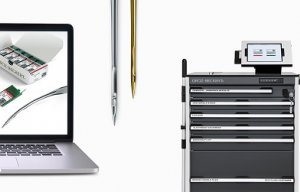
Groz-Beckert presents its sewing product range in Turkey
The latest developments have demonstrated that the use of a nonwoven can significantly increase the service life of battery systems, Groz-Beckert reports.

10th July 2015
Innovation in Textiles
|
Albstadt
The energy transition and the trends in electromobility are demanding improvements in existing materials, or innovations with completely new approaches. As a result, in numerous research projects and in the battery industry, the focus is on new material profiles in combination with industrial plant technology for cost-effective and efficient energy storage.
The latest developments have demonstrated that the use of a nonwoven can significantly increase the service life of battery systems, Groz-Beckert, the leading provided of industrial machine needles, reports.

Depending on the requirements placed on nonwovens as battery separators, Groz-Beckert offers various opportunities to achieve the required properties or optimize the separator through utilization of the right needle.
The task of the separator is to separate the cathode and anode in batteries (the negative and the positive electrodes in accumulators) both electrically, as well as physically and to absorb an electrolyte. This barrier is important for insulating the poles and preventing short-circuits in the batteries, while absorption of the electrolyte is a prerequisite for the ion flow.
The requirements placed on the separator include factors like permeability, porosity, thickness, moisture absorption, swelling, shape and dimensional accuracy, chemical resistance, electrolytic absorption and binding, dielectric strength, thermal stability, tensile strength, pore size, curvature of the edges, as well as shutdown (as a safety feature).
Meeting these numerous requirements constitutes a major challenge for separators. Possible battery separators include microporous polymer membranes, inorganic composite membranes, and nonwovens. Price is a further important criterion in the selection of a suitable separator.

Separators that have to remain stable over many charge/discharge cycles are made of higher-quality materials than those used in inexpensive, disposable batteries. Today's battery industry is now inconceivable without powerful separators and thus without nonwovens, the company reports.
Battery production primarily uses carded nonwovens, wetlaid nonwovens, meltblown fabrics and spunbond fabrics as separators. These are usually still needled or hydroentangled to obtain certain properties, for example, a larger surface by means of felting.
Due to the high process stability of Groz-Beckert products, effects can be generated in the manufacturing process that are just as continuous and reproducible, according to the manufacturer. This is reflected directly in the separator's performance in the battery.

The choice of suitable needle type depends on the raw material used, the fibre fineness, and the desired effect. The GEBECON, EcoStar and CrossSTAR needles are a few of the needle types that have proven themselves in separator production, the company reports.
A common needle-machine configuration in the nonwoven line for producing battery separators often consists of pre-needling followed by the needling process itself.
In pre-needling, conical needles with a barb distance of 4.80 mm and the RF barb shape are often used. Groz-Beckert felting needles with a conical working part are said to differ from standard working-part needles because of their much higher stability.

When using very fine fibres, microfibres or ceramic fibres, the HL barb is recommended for the pre-needling phase, since it is very gentle on the fibres and minimizes breakage and elongation. GEBECON needles are also suitable for pre-needling, especially in the needling of fine fibres and microfibres, since they reduce the risk of needle breakage to a minimum.
Groz-Beckert jetstrips are said to be ideal for battery separators that are hydroentangled in order to produce a larger surface area, the company reports. With sustainable care and expertise for functional parts, Groz-Beckert jetstrips are available in all standard dimensions and hole geometries.

Business intelligence for the fibre, textiles and apparel industries: technologies, innovations, markets, investments, trade policy, sourcing, strategy...
Find out more